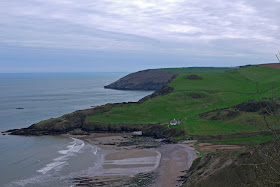Dartmouth Quay
We set out from Dartmouth Quay in bright sunshine on day 3 of our latest session of coast path walking. Very soon we reached Bayard's Cove Castle, a gun post dating from 1537, but built by the town, not by Henry VIII as so many other coastal fortifications were.
We followed the road down the estuary, pausing to enjoy the view back just before Warfleet.
Soon after Warfleet you reach the strangely named St Petrox church - seemingly a corruption of St Peter's. Pevsner describes it as "an old foundation", but comments that the present building dates from 1648.
The nearby castle is visually disfigured by the presence of a lean-to tea room, but is a bit more visually pleasing from the grassy area above nearby Sugary Cove. The Open Spaces Society, a very worthwhile organisation which I had never previously heard of, seem to have been responsible for this pleasant open space.
The castle faces Kingswear Castle in such a way that a chain could be stretched across the river to block the estuary. It dates from about 1380 and was extended a hundred years later.
Further along, there was a fine view across the estuary to Kingswear Castle and, high on the hill to the right, the Tower day beacon inland from Froward Point. It was built in 1864 to guide ships into the estuary. The paddle steamer in the foreground offers leisure trips up the Dart.
Soon we turned Blackstone Point and had a clear view across the estuary to where we walked yesterday.
We climbed a grassy hill then walked across a meadow. As we did so, I spotted a large bird hovering above a neighbouring ploughed field. The binoculars confirmed what I immediately suspected: it was a Perigrine Falcon. We were told yesterday that they bred on the cliffs near Coleton Fishacre, and although we've walked six or seven miles since then it is probably only a mile or two as the predator flies. As ever, by the time I had begun to reach for my telephoto lens it flew off.
Before long we were walking along a grassy hillside and then had to turn inland to make a long detour through Stoke Fleming, where we had some refreshments at the lovely Green Dragon pub - and, perhaps mistakenly, did not visit the early 14th century church with its slender tower
The path eventually returns to the coast above the lovely beach at Blackpool Sands.
We missed a turn here and walked further along the road than necessary, but then took the path on the left down a steep grassy hill and up the other side in the direction of Strete. This tree stood imposingly at the lowest point, overlooking a small cove.
As you approach Strete, the first clear view of Slapton Sands, with Slapton Ley behind it, is presented.
You follow the road through Strete and take a track which gently descends to the Sands at Strete Gate. It becomes clear that "Sands" is a bit of a misnomer as the beach is made of fine pebbles.
We followed the beach and later the Ley for two and a quarter miles to reach Torcross. The Ley is a surprisingly large body of freshwater, home to numerous ducks and legions of midges.
We ended our walk at the Sherman Tank. It is a monument to the loss of many hundreds of American servicemen who died when a landing rehearsal for D-Day was attacked by German E-boats in April 1944. The tank was recovered from the sea many years later.
Conditions: clear and warm, maybe 18 degrees.
Distance: 10.2 miles, a record for us. Distance now covered 164.6 miles.
Map: OL 20 South Devon.
Rating: Four stars.

























































